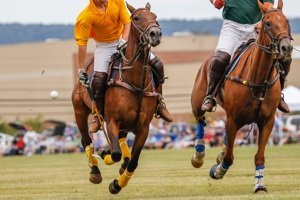Federation of International Polo Rules & Procedures
Federation of International Polo Rules & Procedures. Polo is a lively and thrilling team game that is played on horseback. One of the oldest known sports in the world, it is thought to have started in Persia.
The game as we know it today origins in India in the 1800s, where British soldiers who were stationed there discovered the game being played locally and adapted it for their own uses, sometimes utilizing it as training for cavalry riders.
Brought to Britain soon after, rules were developed and from then on the game spread, and is today played across the world where as well as the UK, it is notably popular in Argentina and the USA. The sport is overseen by the Federation of International Polo.
Players & Equipment
Teams consist of four players, each of whom has a specific role denoted by a jersey number.
The first person on the field is the team’s primary attacker, analogous to a striker in soccer or a forward in hockey. The primary goal of the position 3 players is to score, but when defending, he or she is also responsible for protecting the opposing team’s position 3 players by hitting the ball hard and accurately.
The second-stringer is expected to be mostly an offensive player who will provide support for the first-stringer during attacks. Conversely, they are responsible for defending as well as attacking, and they frequently switch places with the player in position 3 during offensive plays.
Position 3 is analogous to quarterback in that it is typically played by the team’s most talented player. This is an attacking role, hence players in it need to have good ball striking skills to get the ball to the forwards in positions 1 and 2.
The fourth position is a defensive one, and its primary responsibility is to protect the team’s net. However, they are also required to contribute offensively by passing the ball on to the team’s attackers with pinpoint accuracy when they successfully protect the goal.
The most notable piece of equipment is the Polo pony, a horse that has been bred specifically for the sport of Polo. At least two are required for each player so that they can change chukkas as needed. These can be owned by the player or donated by the club. In order for the player to sit safely on the horse, maintain control, and swing the mallet, a specialized saddle is required. A helmet, polo stick, knee pads, and a ball are also required.
Scoring
Goals are worth one point in Polo, and goals are scored by hitting the ball into the goal. Each time a goal is scored in polo, the field is switched to the opposite side from the previous half. It is speculated that this is because teams did not want to play for long stretches of time with the sun or wind in their faces when pitches were usually oriented on an East/West axis.
Rules of Polo
The standard Polo field dimensions are 300 yards in length and 200 yards in width (or 160 yards if it’s a boarded pitch).
The tops of the goalposts are unenclosed, and they span 8 yards in width.
Each chukka (play) in a polo match will last for 7 minutes.
When the umpire tosses the ball between the two teams, play may begin. It is also the method used to resume the game once a goal has been scored.
After each goal is scored, the teams switch ends to cancel out any potential advantages due to the terrain or the weather.
Riders on opposing teams can be challenged by riding up next to an opponent’s pony and trying to steer them away from the ball or even knock them out of the game by “riding them off.” Similar to a body check-in ice hockey, players are allowed to “bump” opponents for added physicality. Players can also attempt to hit the ball by hooking an opponent’s stick.
Two mounted officials, or “umpires,” make calls in a game of polo after consulting with one another. Should they disagree, they might seek the opinion of the match referee also known as the ‘third man’.
There may be a free hit opportunity when a foul is committed.
The team that scores the most goals at the end of the game is the victor.

